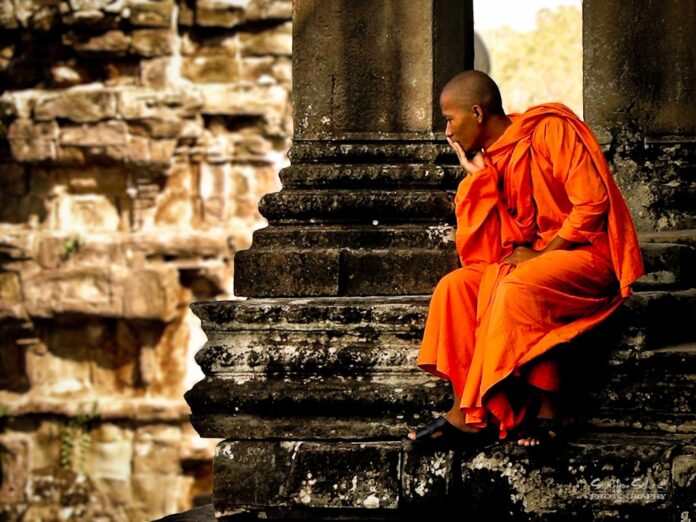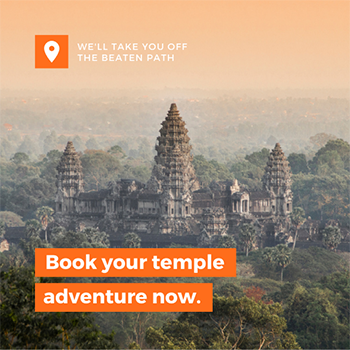The motto of Cambodia is “Nation, Religion, King”. This gives some indication of just how important Buddhism – the national religion – is to cultural and social life in Cambodia.
It is estimated that 95% of the population of Cambodia are Buddhist. Buddhist philosophy permeates nearly all aspects of the culture and in many cases it is difficult to tell where religious traditions stop and cultural niceties start. Adherence to the rituals of Buddhism are more common in the older generation, although the major festivals are celebrated by pretty much the entire population.
History
Hindu was actually the main religious influence for many years of the Khmer Empire, with only a couple of Buddhist Kings ruling. Angkor Wat is the largest Hindu temple in the world – dedicated to Vishnu. However, Buddhism was brought to Cambodia as early as the 5th century AD from the influence of Hindu trading merchants and the Mon kingdoms. Hindu and Buddhism co-existed peacefully in Cambodia for many years, and when Jayavarman VII finally established Buddhism as the national religion, the accepted faith naturally included Hindu symbolism and traditions.
Jayavarman solidified the presence of Buddhism in Cambodia by sending his son to study Theravada Buddhism and be ordained as a monk. As part of the shift from Hinduism to Buddhism, the idea of the god-king gave way to a veneration of monks. The resources placed on constructing great temples to honour these kings waned in favour of building libraries, hospitals and educational facilities – more directed at the development of people than the veneration of a deity. Perhaps this goes some way to explaining the whole-sale shift in religious belief for nearly the entire Khmer population in a relatively short space of time.
Buddhism in day-to-day life
The pagoda is the heart of Cambodian life and many villages, towns, and cities have developed around particularly active pagodas. The pagoda was traditionally the place of education for boys, and many young Cambodian men (generally those from poor backgrounds) still enter the pagoda for anything between one and ten years to benefit from the education provided.
Buddhism teaches reincarnation and karma. Good deeds are rewarded with good consequences, and an elevated status in the subsequent life cycle. Likewise, bad deeds can result in bad consequences and a lower status in the subsequent life cycle. This can explain the seemingly dismissive treatment of poor or disabled people in Cambodian society, as many people believe their misfortune to be the result of actions in their past life.
There are five key precepts in Buddhism which guide people’s behaviour to help them live a happy life:
- To refrain from taking life
- To refrain from taking that which is not given (i.e. theft)
- To refrain from sensual (including sexual) misconduct
- To refrain from lying
- To refrain from intoxicants which lead to loss of mindfulness
Buddhist monks often observe several additional precepts including celibacy, not eating after midday, no entertainment or personal possessions.
Many of the teachings of Buddhism encourage practitioners to overcome suffering, anxiety or dissatisfaction. This feeling is seen as being very common to all human life, and the cessation of it part of what all people should strive for. It is easy to see where this core belief filters through into wider Cambodian culture. In Cambodia, preservation of harmony is more important than fighting for justice or independence. Loud and aggressive persons are thought to be rude, or disrespectful, and confrontation is often avoided at all costs.
Celebrations
Most of the major Cambodian annual festivals are connected with Buddhist festivals. The Khmer New Year celebrations in April include venerations of Buddha statues and offerings at the pagodas. Pchum Ben (festival of the ancestors) in October is held at the end of the traditional 3 month retreat for Buddhist monks.
Weddings and funerals are presided over by monks and nuns, and often new houses, premises or purchases are also blessed by monks for good luck. Water blessings are a common – where people (and sometimes possessions) are fully doused from head-to-toe in blessed water to bring them good luck and protection.
Buddhism and the supernatural
Many of the beliefs that are subscribed to Buddhism in Cambodia actually stem from ideas and practices more closely related to animism and the spirit world than Buddhism. There is a strong belief in ghosts and spirits especially in rural communities. Most plots of land have spirit houses – miniature wooden houses where incense and offerings are placed to placate the spirits of the land that are being disturbed by the people living there. Belief in spirits also translates into many traditional medicinal and healing practices, which are sometimes in turn linked back to monks and Buddhism. Many Cambodians will seek out assistance from monks or healers if they are ill rather than doctors. There is also a strong belief in fortune-telling and visionaries, and experts in this area regularly consulted to help with important decisions such as investing in property, long travels, or matters concerning marriage and families.
Other religious minorities
Despite being the main religion of Cambodia for many years, Hinduism is now pretty much non-existent in Cambodia. The largest minority religion is Islam, practiced by Cham Muslims, one of Cambodia’s tribal minorities. There are approximately 200,000 Cham Muslims in Cambodia – previously there were many more but the group was heavily persecuted during the Khmer Rouge regime.
Christianity was introduced to Cambodia centuries ago, but failed to take root due to the strong loyalty of the people to their King and his religion. Even with the establishment of the French Protectorate neither Christianity nor grew Catholicism much during the 20th century. After the fall of the Khmer Rouge the influx of faith-based NGOs may have resulted in a slight increase in awareness of the religion. A notable growing religious population is that of The Church of Jesus Christ of Latter Day Saints (commonly known as the Mormons) who in the last 15 years have established 31 congregations.
With the obvious exception of the Khmer Rouge era, when no religion was acceptable, Cambodia has historically been a tolerant country in terms of religious attitudes. Religion is largely disassociated from politics, and the times when monks have become involved have been limited and very controversial. Buddhism, Hinduism, animism and superstition have all combined together over the years to reflect the rhythms of traditional Cambodian life and become an undercurrent to Cambodian national identity. One of the many crimes of the Khmer Rouge was to strip away this identity, leaving a confused and vulnerable population. Now, as the younger generation turn away from the pagodas and traditions in favour of capitalism, globalisation and consumerism, the older generation are becoming nervous at the idea of losing, once more, those beliefs that help define themselves and their nation.



